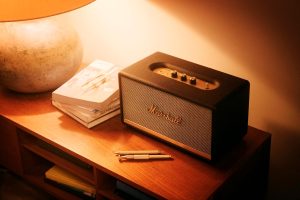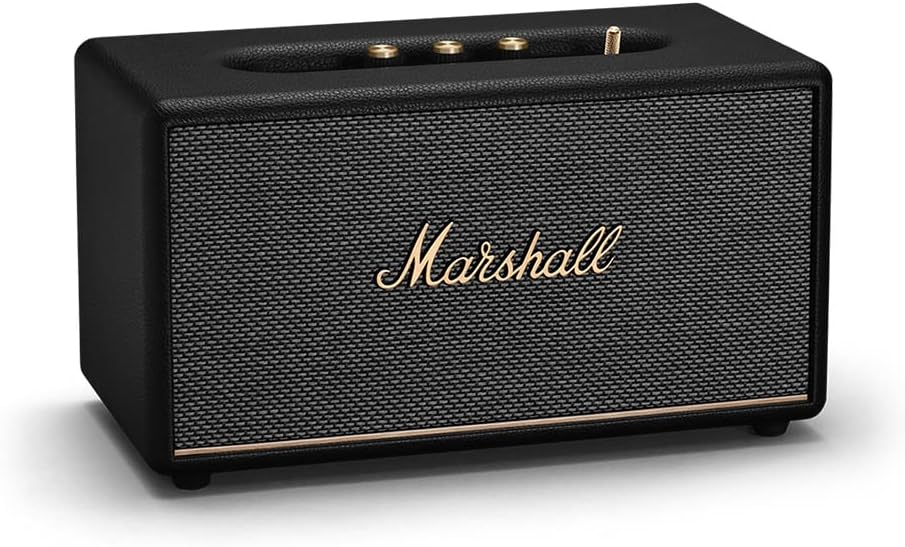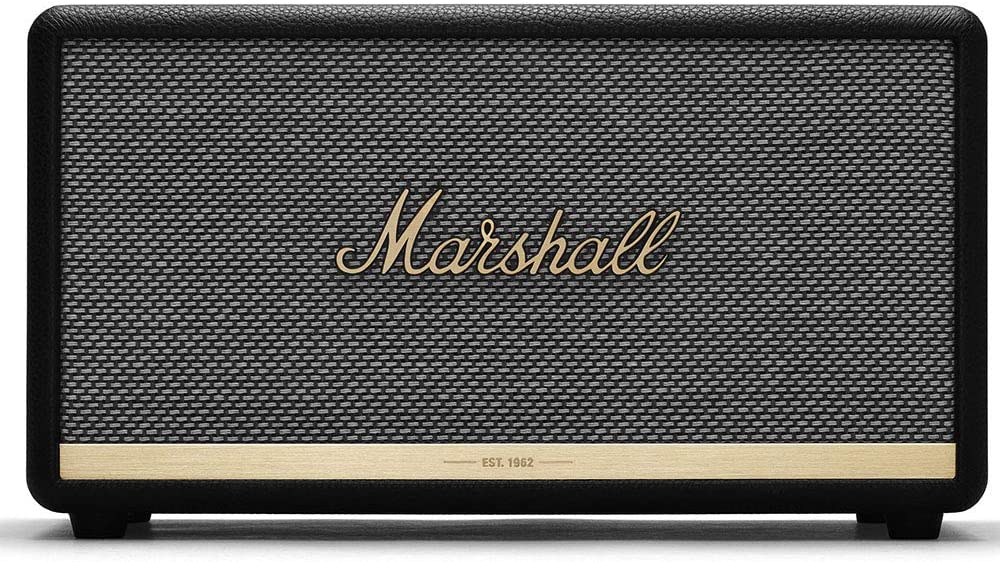There are speakers you buy for convenience, and then there are speakers you choose because they’ve got character. The kind that look like they belong in a smoky studio, or on the shelf next to your vinyl collection. And if you’re eyeing the Marshall Stanmore II or the Stanmore III, you’re already in that second group. But here’s the kicker: they look almost identical. You place them side by side, and at first, nothing screams “new and improved.” So you ask yourself, is the third edition just more of the same? Or is there something deeper hiding behind the knobs?
That’s exactly what we wanted to know. Because both of these models promise loud, room-filling sound with a heavy dose of nostalgia, but only one is the newer kid on the block. And knowing how Marshall operates, they don’t change stuff just to keep the product page fresh—they usually tweak things where it counts.
We spent time living with both, testing them out in everyday scenarios—low-key evenings, full-volume Saturdays, even during cleaning sprees where the music needs to push you through—and now we’re ready to compare every detail. You’re here because you want the truth, not the specs page copy. Let’s get into it.
The visual charm gets a haircut—but stays true

You know that moment when a band you love changes just enough to feel modern, but not enough to alienate long-time fans? That’s the vibe here. The Stanmore III trims down slightly in both size and weight, but it’s still unmistakably Marshall. That black (or cream or brown) vinyl wrap, the textured finish, the old-school script—everything is still there, still oozing that vintage guitar amp feel.
The gold line at the bottom edge has been slimmed down, and although that sounds like a tiny thing, it actually gives the newer model a slightly more contemporary silhouette. Cleaner. Sharper. Less ornamental.
And for those of us who obsess over controls—because let’s admit it, part of the fun is turning knobs instead of swiping screens—the Stanmore III now includes a new button. Just a small forward/back track button, but honestly, it makes streaming sessions way more tactile. You no longer have to dig for your phone every time you want to skip a song.
Everything else? Same layout. Same throwback magic. Same metal toggle power switch that still feels like flipping a light switch in a 1960s studio.
Familiar muscle, but with finer tuning
Sound is where things start to shift. Not dramatically, but noticeably—especially if you’re the kind of listener who picks up on subtleties.
Under the hood, both speakers are running a familiar setup: a 50W Class D amp driving the woofer, with two 15W amps for the tweeters. That gives you punchy mids, strong highs, and enough bass to make your neighbors mildly annoyed.
But here’s where the III edges ahead. Marshall has angled the tweeters slightly outward, and what that does is create a wider, more even dispersion of high frequencies across the room. You don’t have to be parked dead center anymore. The stereo image holds up better even if you’re pacing around while on a call or cleaning up.
Also, the frequency range on the Stanmore III stretches down to 45 Hz, compared to 50 Hz on the Stanmore II. Is that a huge difference? Not exactly. But those five extra Hz mean slightly fuller, deeper lows, especially on well-mixed tracks. If you’re into bass-heavy music, you’ll hear it.
Bluetooth keeps up with the times
Connectivity is one of those areas where time moves fast. What was top-shelf two years ago can feel outdated today. So it’s good to see that Marshall upgraded the Stanmore III’s Bluetooth from version 5.0 to 5.2, and added support for Bluetooth LE Audio.
Now, Bluetooth LE Audio isn’t yet a daily must-have, because most devices haven’t fully adopted it. But once it becomes standard, the Stanmore III will already be compatible, which means better efficiency, less battery drain (if that ever comes into play), and potentially better audio performance.
In real-world use, though? You’re not going to notice a huge difference right now, unless your phone also supports the newer standard. Both speakers pair quickly, maintain stable connections, and give you the same wireless range—about 10 meters.
App features are the same deal
So here’s the thing: both the Stanmore II and III rely on the same Marshall Bluetooth app. It does what it needs to do—lets you adjust EQ, update firmware, and switch between devices—but don’t expect any special tricks on the newer model.
No WiFi support, no app-based multi-room playback, and no cloud syncing. This is all Bluetooth, all local. For some users, that’s a limitation. For others, it’s the whole point: no clutter, no nonsense.
The EQ sliders in the app mimic the physical knobs, so if you’re controlling things from the couch, it still feels connected to the speaker’s tactile personality.
No smart speaker nonsense—and that’s intentional

Let’s get this out of the way: neither the Stanmore II nor the III comes with a microphone or voice assistant support. No Siri. No Alexa. No “Hey Google.” If that’s a dealbreaker for you, look elsewhere.
But honestly? We’re okay with it. Because this speaker isn’t trying to be a do-it-all smart home hub. It’s focused. It plays music. It sounds good. That’s it.
No one’s eavesdropping, nothing is “listening” in the background, and there’s no surprise firmware update that suddenly makes the speaker do something weird. Just you, the music, and that analog-style control panel.
Inputs that keep it versatile
Bluetooth is great, but sometimes you just want to plug in. And here, nothing’s changed—which is kind of the point.
Both the Stanmore II and III include a 3.5 mm aux input and RCA inputs. That means you can hook up a turntable, a cassette deck, a laptop, even a DJ controller. Anything with analog output? You’re covered.
It’s these classic inputs that make both speakers surprisingly versatile, especially if you’ve got gear that doesn’t support wireless. No adapters. No converters. Just cables and music.
The hands-on interface we still love
This is probably one of the most charming parts of the Marshall experience. You don’t swipe or tap to raise the volume. You twist a knob. You flick a toggle switch. And it feels satisfying every time.
The Stanmore III adds that new track control button, which feels like a natural addition—especially if you stream a lot from your phone. But otherwise, it’s the same deliciously analog user experience, and we’re not complaining.
The knobs have great resistance, they don’t feel cheap, and the entire top panel layout still looks like it came from a 1975 recording studio. You’ll want to reach for it, not hide it.
Build quality? Same DNA
There’s a reason these things last. Both the Stanmore II and III are tank-like, in the best way. Vinyl covering resists scuffs, the grille holds firm, and the knobs and buttons feel like they were built to be played with, not just touched once and left alone.
That said, neither speaker is water-resistant, so don’t take them to the patio during a drizzle. They’re indoor units, through and through.
They’ll survive moves, bumps, and years of daily use, but don’t expect them to be party-proof or poolside-ready.
Filling the room? No problem for either

We threw everything at these speakers—hip-hop, jazz, doom metal, ambient, acoustic—and they both held it together. Both models push around 97 to 101 dB, which is more than enough to fill most spaces without distortion.
But here’s where the III gets its moment again. The wider tweeter angle gives it slightly more balance when you’re moving around the room. It feels less directional, more immersive. You’re not stuck in a sweet spot. The stereo image is just a bit more forgiving, which makes casual listening more satisfying.
Not for the backpack—but easier to move
Neither of these is portable. Let’s be real. They need power, and they’re hefty enough that you won’t toss them in a tote.
But the Stanmore III is a little lighter, a little slimmer, and if you need to reposition it—say from shelf to desk—it’s less of a pain.
Still, don’t expect battery life or handles. If you’re looking for something portable, this isn’t the right category. This is a speaker you place and keep there.
And here’s where we land…
We didn’t expect much. Honestly, we thought it would be a toss-up, maybe even lean nostalgic toward the Stanmore II. But after using both, we get it now.
The Marshall Stanmore III isn’t a reinvention—it’s a precision edit. Just enough to make daily use better. The wider tweeter angle? Useful. The slightly deeper bass? Audible. The added button? Convenient. And the Bluetooth update? Quietly future-proofing the thing without asking for attention.
If you already have a Stanmore II, you’re not missing anything essential. But if you’re choosing between the two right now? Go with the Stanmore III. It’s the same spirit, the same soul, but with a few thoughtful tweaks that make a difference when you’re living with it.
No drama. No reinvention. Just evolution—the kind that knows exactly what to keep and what to nudge forward.


